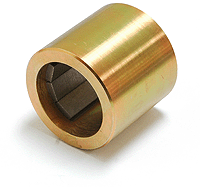Samarium Cobalt magnets fall into the following groups:
Series 1-5 (SmCo5)
These samarium cobalt magnet alloys have one atom of rare earth Samarium and five atoms of Cobalt. By weight this samarium cobalt magnet alloy will typically contain 36% Samarium with the balance Cobalt. The energy products of these samarium cobalt alloys range from 16 MGOe to 25 MGOe. These Samarium Cobalt magnets generally have a reversible temperature coefficient of -0.05%/°C. Saturation magnetization can be achieved with a moderate magnetizing field. This series of Samarium Cobalt magnet is easier to calibrate to a specific magnetic field than the SmCo 2-17 series magnets.
In the presence of a moderately strong magnetic field, unmagnetized magnets of this series will try to align its orietation axis to the magnetic field. Unmagnetized magnets of this series when exposed to moderately strong fields will get slightly magnetized. This can be an issue if post processing requires that the magnet be plated or coated. The slight field that the magnet picks up can attract debris during the plating or coating process causing for a potential plating or coating failure or a mechanically out of tolerance condition.
Machining or grinding this magnet by the user is discouraged. This material must be ground using diamond cutting and grinding tools and a significant amount of water based coolant. Dry ground powder can iqnite spontaneously with a small spark.
The coercivity is controlled by a process known as “nucleation”. S1665, S1865, S2064, S2065 and S2069 are Samarium Cobalt magnet alloys made from the Series 1-5 alloy.
Series 2-17 (Sm2Co17)
These Samarium Cobalt magnet alloys are an age hardening type with a composition of two atoms of rare earth Samarium Cobalt and 13-17 atoms of transition metals (TM). The TM content is rich in cobalt, but contains other elements such as iron and copper. Other elements like zirconium, hafnium and such may be added in small quantities to achieve better heat treatment response. By weight the alloy will generally contain 25% of Samarium. The maximum energy products of these alloys range from 20 MGOe to 32 MGOe. These alloys have the best reversible temperature coefficient of all rare earth alloys, typically being -0.03%/°C. The “second generation” Samarium Cobalt materials can also be used at higher temperatures. The most advanced Samarium Cobalt material offered by MCE is S3069 which has a guaranteed maximum energy product of 29.5 MGOe minimum. All the SmCo alloys with energy products that are 22 MGOe and higher that MCE offers are made from the Series 2-17 alloy.
Bonded Samarium Cobalt

The bonded Samarium Cobalt materials are typically anisotropic and manufactured by using “binders” such as epoxy resins to hold the powder in place, rather than “sintering” the alloy. Energy products of the bonded magnet range from 5 MGOe to 15.1 MGOe. MCE offers two grades of the bonded samarium cobalt material.
Sintered Samarium Cobalt

Sintered Samarium Cobalt magnets are inherently very brittle, and conventional machining techniques cannot be used. If machining is required, high concentration diamond grinding wheels must be used, and water coolant is necessary. The grinding dust produced from machining Samarium Cobalt is a fire hazard when dry since it can reach an ignition point at low temperatures. Samarium Cobalt powder can spontaneously ignite from just a small electrostatic spark.
Sintered Samarium Cobalt magnets, similar to other magnet materials, are formulated for their magnetic properties and not their mechanical properties. As such, they must not be used as mechanical members, or expect to exhibit superior mechanical characteristics. As with sintered metullurgy, one should expect to find imperfections such as minor hairline cracks, porosity, voids, cold flow, shrinkage, pipe and others such as commonly found in cast or sintered metallic magnets.
Magnetizing Samarium Cobalt
Magnetizing Samarium Cobalt magnet materials require very large magnetizing fields to saturate the material. Fields in excess of 35,000 Oersteds should be used. In the event the Samarium Cobalt magnet is inside an assembly and magnetized post assembly, greater fields are required to ensure saturation.
Using Samarium Cobalt Magnets
Generally, Samarium Cobalt magnets do not need any coatings or platings after processing. Occasionally coating with advanced coatings such as PR1010 is desirable if cleanliness is an issue. The coating in this case acts much like a sealant. Oxidation is not a factor. Occasionally the Samarium Cobalt (SmCo) magnet may have some areas that discolor and appear as oxidation. This is typically due to some iron impurities and is generally not a cause for plating; the rusting appearance is typically localized in areas and after some discoloration, does not continue through the material.

Occasionally Samarium Cobalt magnets are plated with Nickel. This is generally done if the magnets are used in a vacuum so that a vacuum cleaning can be accomplished prior to assembly. It is easier to “wipe down” a nickel plated Samarium Cobalt magnet than to try to clean an unplated magnet.